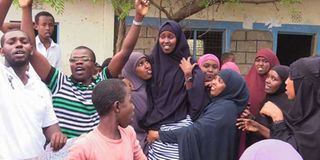Improve education in northeastern region

Teachers and parents celebrate with top pupil in Garissa County Farhyia Ahmed Khalif from Sunshine Academy who scored 423 marks out of possible 500 becoming top in the county. PHOTO | NATION MEDIA GROUP
What you need to know:
- The tutors formed the core of the teaching fraternity in the region.
- A host of factors cause this continual poor performance.
Northeastern Kenya was nowhere near the bright side of the 2017 KCSE examination results.
Not a single candidate from the region was in the “Matiang’i 142” — the top cream of students who scored straight As. No school was among the top 100.
I could only see mini-celebrations on social media for the few who managed to get by.
But whereas others blamed their poor performance on the swiftness with which the exam was marked, for the dozens of northeastern students (who were ‘leading from behind’), the education quandary stretches far and wide.
TERRORISM
Terrorism has hugely contributed to the worsening situation of education in the sandswept region. Somalia-based and Al-Qaida-linked terrorist group Al-Shabaab killed 28 and 36 Kenyans in the late 2014 bus and quarry massacres respectively in Mandera County.
Then on April 2, 2015, they killed nearly 150 people, mainly non-local students, in the Garissa University College attack.
As a consequence, more than 1,000 teachers from other counties fled the region, causing the immediate closure of 95 public schools.
The tutors formed the core of the teaching fraternity in the region.
Sadly, the capacious vacuum has not been filled, leaving local school-going children to their own devices.
That is despite the significant resumption of peace since Mr Mohamud Ali Swaleh was recalled from his ambassadorial duties in Saudi Arabia in mid 2015 and specially appointed as North Eastern regional coordinator.
Mr Swaleh is credited with ending a long period of banditry attributed to the Shifta within his one-and-a-half years as the provincial commissioner between 2001-2003.
TEACHERS
At one time, the government promised to partner with the region’s three county governments — Garissa, Wajir and Mandera — to train more local residents as teachers. But that is yet to happen. On the contrary, it plans to raise the admission grades for primary and secondary teacher training colleges, a move that will further narrow the chances of the already outnumbered locals in the teaching profession.
But even prior to the advent of terrorism, students in the region have characteristically lagged behind in education and national exam performance.
According to officials, only 10-15 per cent of the local students who sit the KCSE exam have been joining university since time immemorial. The rest try their luck in the disciplined forces, business or move out of the country in search of a better life.
The majority luckless lot, wallowing in despair, end up joining the murky world of drug abuse, crime and prostitution.
Unless the government taps into this prime but unutilised potential, desperate youth will continue to be hoodwinked to join terrorist groups — as has been witnessed in domestic terror attacks.
DRUG ABUSE
A host of factors cause this continual poor performance.
They include low motivation among students due to lack of sufficient mentorship programmes and role models, poor educational infrastructure and resources, cultural obstacles, poverty, low quantity and quality of teachers and the hot climate that reduces human activity from midday.
There is also drug abuse among students and teachers; students getting into romantic relationships, preoccupation with social media and movies, as well as a general laxity among learners, parents and teachers in education matters.
The government should spearhead the holistic resolution of the challenges in the historically marginalised region so that local students can also appear in the mainstream media celebrating good exam performance like their peers elsewhere.
Mr Mohamed is a ‘Nation’ correspondent in Garissa. [email protected].





